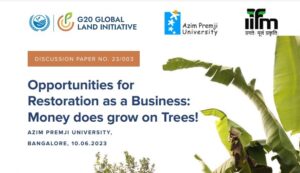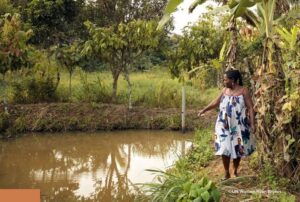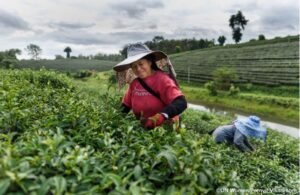
This Discussion Paper was originally published here. It is republished on this website with permissions.
The Big Picture: Making the planet a happier place!
Land degradation is a global issue and already there are global commitments to restore over 1 billion hectares of land (3x India). Economic analysis of land restoration shows that investing one dollar in land restoration can produce a return of 7 to 30 dollars. This leads to great opportunities to invest in a sustainable future for people, planet and profit.
Laws are getting in place that make land regeneration mandatory. The proposed EU Restoration law mandates 90 % restoration of degraded lands by 2050.
Land restoration investments range from 1000 USD to 30.000 USD per hectare but in the Global South they are usually below 5000 USD.
There are global commitments for up to 100 billion USD per year for climate change adaptation and mitigation measures. Investment in Nature based Solutions are by far the most promising in terms of impact and ROI. Another 200 billion USD has been requested to restore ecosystems in Montreal.
The voluntary carbon offsetting market is taking off after a slow start and bringing significant resources into the restoration market and is estimated to be tens of billions of dollars per year by 2030, with prices for quality projects of at least at 30 USD/Ton by 2030. In fact those prices are already being paid by parties like Microsoft.

A MULTI-TRILLION DOLLAR REGENERATION INDUSTRY IS ABOUT TO EMERGE.

-
Opportunities
1.1 Climate finance and other Funding Mechanisms
- Carbon financing is growing at a rapid pace and is bringing significant resources into the restoration market and carbon credit prices are expected to rise
- Newer mechanisms like water and biodiversity credits and payment for ecosystem services have emerged which may compensate those who create positive externalities (public goods) through land-restoration. There have already been success stories like Project Eden, UNFCCC registered A/R CDM project developed by VEDA Climate Change Solutions Ltd linking land restoration with climate change mitigation and improving livelihoods.
- There are many other ecological, credits and blockchain-based tokens entering the market
- Investment banks or other companies may pool resources from individual investors and spend the money on activities which restore land and generate returns, making investment available to all scales of projects.
- Impact financing/crowd-funding can provide funding to all scales of projects.
- Potential funding from pension/sovereign wealth funds dramatically increases available funds.
1.2 Market, demand and player perception is evolving
- For B2C businesses (Business to consumers)
- Public perception is evolving. Restoration can be positioned as something sexy
- Changing mindsets of millennials, middle-class and richer sections who are willing to pay a premium price for sustainably produced goods and services.
- Very large potentially addressable market
- For B2B businesses (Business to Business)
- ESG demands from large companies to reorganize their supply chains towards non degrading procurement and net zero business activities.
- New business opportunities
- New market for insurance providers: disaster risk reduction/ forest fires as a frame for business models (also parametrix insurance policies (e.g. new policies to provide restoration funding for coral reefs after hurricanes) – insurance providers/ risk finance has to work together. Well designed regeneration projects mitigate those risks.
1.3 Public-private-people partnerships
- Large scale government commitments for regeneration will increase the scale of public-private people partnerships.
1.4 Technology
- Increasing availability of technologies to support restoration and newcomers to the field (examples at the end of the document)
- Improved planting stock and climate tolerant species for sharing and dispersal, reducing risk of crop failure, important for food security
- New, blockchain-based systems to introduce scale, speed, granularity and trust with no low entrance barrier for businesses
- Easier, more standardized, digitalized monitoring and evaluation
1.5 Knowledge sharing
- Increasing availability of practical tools/guidance and academic repositories of accessible knowledge for implementing effective restoration projects
-
Restoration Challenges
3.1 Overarching
- Lack of definition of what is a restoration business
- We need to develop appropriate solutions that are tied to degradation causes
- Lack of awareness about possible business models/how to get out of ‘business as usual’
- Need to create incentives for responsible, holistic restoration businesses ensuring equity for stakeholders
- Risk and uncertainty
- There is still much consensus to be built in the valuation of public goods like clean air, water, biodiversity, soil among others.
3.2 Institutional challenges
- Lack of appropriate institutional mechanisms to promote restoration.
- Interdisciplinary and interorganizational (e.g. government/non government/private) mechanisms are needed in the form of Special Purpose Vehicles (SPVs) to support coordinated management of restoration in specific sectors or ecosystems (e.g. agriculture, forestry, fisheries)
3.3 Legal/Policy challenges
- Need framework to allow large-scale restoration action to be undertaken on a commercial basis
- Current land concession/tenure rights tend to disincentivize restoration.
- Government subsidies/finance/policies as well as global finance mechanisms may perpetuate unsustainable and land-degrading activities.
- Small and fragmented land holdings/ ownership disincentive restoration
- All legal approaches to date are reactive (e.g. polluters pay), there are no proactive restoration legal frameworks (e.g. precautionary principle)
3.4 Market challenges
- The lack of enabling instruments which enhance the confidence of consumers who buy products from land-restoring supply-chains makes the markets for such products thinner.
- Economic systems are traditionally set up to be extractive which results in large-scale land degradation. There has not been enough attempt made to hold producers responsible for the negative externalities that their business practices cause. (Economics doesn’t fairly account for restoration benefits)
- Many primary producers (like farmers) are compelled to use land in a degrading manner because of market demands, ill-designed subsidies and lack of viable alternatives.
- Demand for certain products exceeds sustainable supply.
- Lack of a marketable / saleable product
- Transaction costs (e.g. for certification) increases prices, which may keep the market for ethically sourced or sustainably designed products small.
- Limited demand, at high volume levels, for products from restoration-oriented businesses.
- Limited awareness around carbon markets and lack of easy access to tradable credits
- No easy system for payment for ecosystem services
3.5 Financial challenges
- Finance mechanisms are inadequate.
- A lack of financing mechanisms for smaller holders which limits economic viability and arrests ability to scale.
- Absence of financial models such as blended finance.
- Mismatch in scale between finance institutions and small-holders
- High transaction costs – labor, data collection, verification, transport
- Carbon markets may create perverse incentives that result in degradation to land and biodiversity
3.6 Technical challenges
- Standards
- Standards exist but aren’t being adopted.
- Specific ecosystem and sector standards still needed.
- Certification
- No standardization for certification of when you are actually achieving net gain, including gain that can be traded through carbon, ecological, or biodiversity credits.
- Few entities recognize or require certified practitioners
- Monitoring
- Most existing monitoring is not outcomes based
- Monitoring isn’t standardized, though some recommendations exist (e.g. Restoration Project Information Sharing Framework monitoring recommendations; Framework on Ecosystem Restoration Monitoring).
- Need for stringent measurement, reporting and verification which can be linked to financing and to project certification/credit trading
- A lack of restoration capacity and technical skills
- Lack of training about restoration
- Limited education programs, especially at local level
- Limited knowledge sharing, especially in local languages/at ground level
3.7 Social Challenges
- Land holding and tenure rights including equity (also legal/policy)
- IP Rights, propriety; Indigenous knowledge ownership (also legal)
- Conflict of interest hinders desire to restore
- Local communities ignored in name of business profit
- Equitable distribution of benefits
-
Recommendations
4.1 Communication:
- Repository of best practices and success stories: Mapping case studies and best practices / success stories of restoration projects (such as Restor, WOCAT UNCCD SLM Database, SER restoration projects database) . Co-ordinating, enhancing and promoting existing databases. Making them more accessible to the restoration community
- Mapping the ecosystem of restoration business and identifying synergies, opportunities and gaps.
- Work on Restoration economy, that includes empowering local entrepreneurs to apply local solutions and support to identify the economic activity that is associated with regenerative land use such as ecological restoration.
- Working towards access to information and resources, for example there are government and social development programs from Corporates or Responsible Producers/ consumers for regenerative land use that need to be available to the small farmers. Solar pumps for irrigation, organic farming, microirrigation, genetic pool resources conservation, Program of Activities of Carbon credit etc.
4.2 Recommendations for G20
- Support, promote and help to integrate a restoration movement in all G20 countries.
- Clear communication around regeneration
- Create a targeted marketing campaign for regeneration
- Create easy communication networks – Social media/whatsapp
- Strengthen and disseminate values around restoration – make it fun and meaningful, especially for the youth
- Focus on restoration and well-being as a value
- Disseminate success stories to provide inspiration – curated list indicating embedded business models
- Create Support mechanisms
- Capacity building (online, Moocs, local forums, multi-tiered forums)
- Create a network of regenerative accelerators
- Access to technology: a repository of tools
- Start-up demo days
- Restoration business mentoring networks
- Organize a yearly returning Regeneration Global Trade Fair / Exhibition or organize a regeneration pavilion on a fair like https://www.biofach.de/en
- Involve the food/beauty/fmcg industry in the discussions and create support mechanisms and incentives to motivate them to become stakeholders in restoration through responsible sourcing and waste management practices.
- Mobilise finance from Governments, Multilateral and bilateral development agencies, private sector, Foundations etc for restoration Activities.
- Link restoration activities with climate change mitigation and enhancing livelihoods.
- Promote ‘business unusual’ with innovative financial models such as blended finance etc.
-
Digital References
5.1 Project Databases
Restor
Ecosystem Restoration Big Map
explorer.land
One Earth Project Marketplace
Evergreening Monitor
WOCAT Global Database on Sustainable Land Management
5.2 Links to existing businesses, including regenerative finance: A lot are in early stages but will bring scaling solutions to regeneration across landscapes
https://regenerativeresources.co/
https://thelandbankinggroup.com/
https://www.ecometricsllc.com/
https://pacificbiochar.com/
Inventing a new way to grow native timber and food in Brazil | Initiative 20×20
https://www.regen.network/
https://www.thallo.io/#
https://brainforest.global/
https://www.forestwise.earth/
https://www.ecosia.org/?c=en
https://www.courageousland.com/
https://www.openforestprotocol.org/
https://joinseeds.earth/
https://www.orgo.eco/about — kumo
https://www.viridisterra.com/
https://www.refidao.com/
Digital Gaia
https://www.klimadao.finance/
https://regeneration.org/
https://re.green/
https://gedi.umd.edu/ (this is not a business, but it will give you an insight into how we can soon apply data sets to assessing forests from lidar and other satellite data. MRV will soon be a combination of satellite data and community delivered data combined in assessing regenerative results which will lead to remuneration)
Tree book library: Friends of the Trees on Library Thing
Measurements and definitions: https://www.thelexicon.org/
Regeneration tools in the ideation or design phase:
Arara Regenerative Project & Business model.docx
Seed Collection and Distribution Platform
Digital Gaia – Sketch of a digital architecture for global regeneration – editable.docx
Working group participants and contributors:
Brook Assefa, Save Soil Movement
Bethanie Walder, SER
Dr. Omprakash, IIFM
Dirk-Jan Oudshoorn, Forest Wise
Dr. Satyanarayana Masabathula, VEDA Climate Change Solutions Ltd (VCCSL)
Dr. Sunayana Ganguly, Azim Premji University
Muralee Thummarukudy, G20 Land Initiative
Ramesh Venkatraman, SER
Rob de Laet, Fellow of the Global Evergreening Alliance
Tanguy Yu, Astungkara Way

